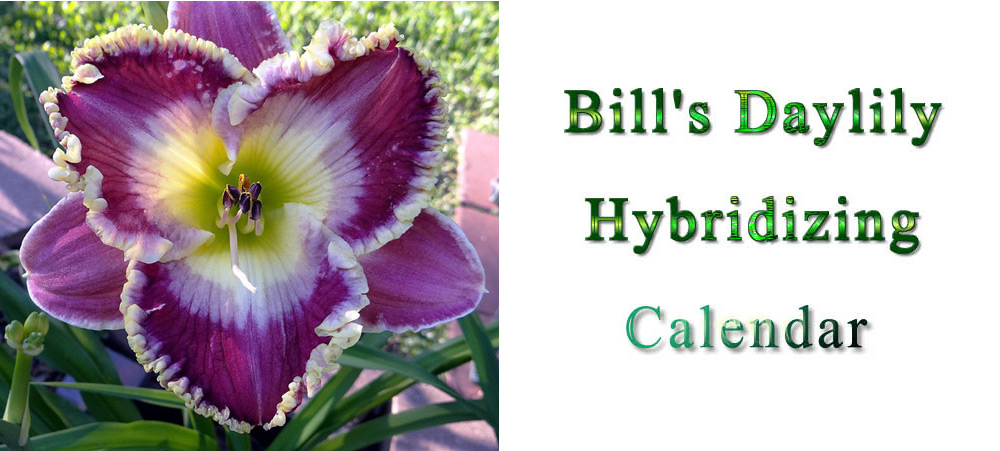September
Time to plant the new seed crop!
|
Labor Day weekend is my traditional seed planting time and this year is no exception. Having 3 consecutive days allows me to relax while planting. Even if one day is a complete washout I can still finish before I have to go back to work at my day job.
I plant my seeds in #38 tree trays so named because there are 38 cells per tray and each cell is about 5" deep to give room for tree seedling roots.
|
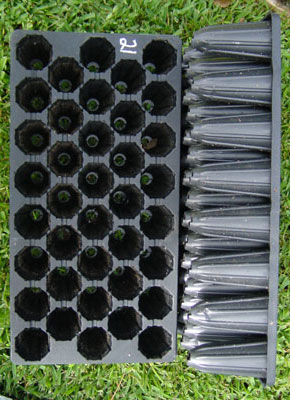
|
|
I start my seeds in a special growing medium called Pro-Mix BX. Over the years I have tried mixing my own seed starter soil and while each mix did work (some better than others), the Pro-Mix works better than anything I was able to put together. This is probably because Pro-Mix has Mycorrhiza added. Mycorrhiza is a beneficial fungus that helps plant roots better absorb water and mineral nutrients.
Pro-Mix (BX blend) contains 75-85% Canadian sphagnum peat moss, horticultural grade vermiculite and perlite, dolomitic and calcitic limestone (to adjust pH), and a wetting agent.
I plant the seeds about twice as deep as they are fat (1/4" to 1/2" deep) following my planting spreadsheet (see August post) carefully. I plant about 1/3 more seeds than I have room for in the garden. Not all seeds will germinate and some of the ones that do germinate will not be strong growers. Overplanting gives me the ability to select only the best seedlings for transplanting.
|
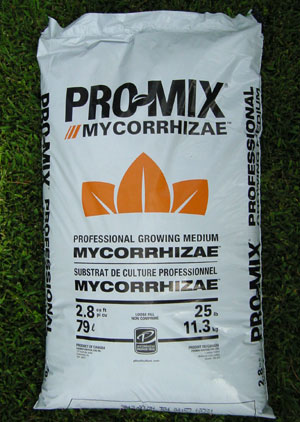
|
|
|
The results
|
After planting, trays are set in their usual home (my driveway) where they will remain until it's time to transplant the seedlings. The 40 trays occupy a space that's only 7 feet by 9 feet.
Not apparent in the photo is the chicken wire that I have the trays covered with. The neighborhood has many squirrels and they will dig in any fresh soil to see if I buried something edible. Unfortunately that includes my seed trays (grrrr...). They can and have done great damage to my hard work and the chicken wire helps keep them at bay.
|
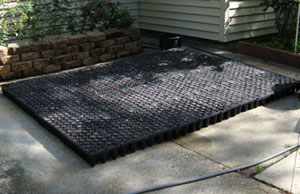
|
Planting the seeds is a very relaxing time for me. I sit in the shade, listen to music on my headphones, and plant seeds. Because my planting guide includes the pod and pollen plants for each cross, I am able to daydream about what I might get out of the resulting seedlings.
|
|
|
Identify the parents of the new selected seedlings
Over the years I have tried to find ways to save myself a little time here and there. One of these timesavers is I don't label each cross as they're planted in the seedling beds. Instead, I just place blank plant markers to separate the crosses and keep track of which crosses are planted where in a 'seeds planted' spreadsheet on my computer.
I also don't try to identify the parentage at the time I'm flagging the seedlings because the foliage is often very thick and it's difficult to find the individual markers between crosses. Instead, I wait until September when foliage is reduced and the markers easier to see. I then go through and identify the cross that's associated with each numbered flag and enter the information the new seedlings spreadsheet. Now I have names to match the faces (crosses to match the pictures I took).
Sometimes there will be no plant where the flag was placed. Occasionally, new seedlings will expire after they bloom. I'm not sure why but in my option it indicates the plant had a weakness of some sort. I'd rather lose it early on instead of after devoting 2 or 3 years evaluating it. I remove the flags and note the seedling's demise in my new seedling spreadsheet.
|
Check the evaluation bed for seedlings with performance problems.
This is a good time to do a walk thru of the seedling evaluation beds to see how each plant looked after almost 4 months of consecutive 90+ degree days. I don't like daylilies that are puny by the end of the summer. Small or otherwise poor looking fans are usually the result of a plant that is not a robust grower and I prefer vigorous growers. So I not only evaluate how a plant blooms but also how it looks at various times during the season.
|
Sometimes an otherwise healthy daylily will bloom itself to the point where the fans will only be a few inches high by the end of the season. Such was the case for this seedling. I grew it for several years hoping it would better establish itself to no avail. It would rebloom until the fans would shrink to only a few inches in height. The following year it wouldn't bloom at all. Finally one year it bloomed itself to death. To me this is an undesirable trait (smile).
Seriously, a plant that looks poorly at this time of year will usually find itself in the compost heap unless it has something special to offer as a breeding plant. If the trait is special enough I may keep the plant for pollen use to see if the special trait can be passed on without passing on the poor performance.
|
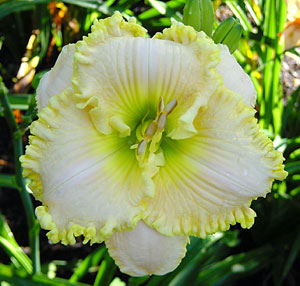
|
|
Decision time in the evaluation beds
I now have a number of new seedlings that need a home in my evaluation beds. I only have a limited number of spaces for evaluation seedlings so I have to make some decisions about which stay another year and which have to go to make room for new ones. Here's how I review each seedling to place it on either the keep or the remove list.
These are the removals:
- Throw aways - these include the puny growers, the non-bloomers, the bloomers that got uglier instead of prettier, those with undesirable traits like 4" bloom on a 48" scape, and the ones that make me scratch my head and wonder why I decided to evaluate it in the first place.
- Give aways - these are plants that are 'ok' but don't have any redeeming qualities. They are usually common looking blooms with less than acceptable bud counts. There's a lady in my neighborhood who just loves these and she gets them every year.
- Yard sale plants - plants that make it to this group include excellent performers with relatively common looking blooms and average performers with better than average looking blooms. These are plants that I have decided not to register and are sold at a low price to local gardeners to help promote daylilies.
- Seedlings that I have decided to register - once I register a seedling it is removed and planted with other registered cultivars.
These are the keepers:
- plants that have been in the evaluation bed for only 1 year - in most cases I don't remove seedlings that have not been evaluated through 2 bloom seasons. Many seedlings don't show their true potential until they've been undisturbed for 2 years.
- Probable future introductions - there's never enough of these (smile).
- Seedlings I'm not ready to make a decision about - further evaluation needed.
- Seedlings that are not candidates for introduction but possibly have something to offer for breeding purposes. I keep these for use in my hybridizing.
|
There are always a few seedlings that have many of the traits that make it a candidate for registration but for some reason I can't decide to register it. This seedling is one of those. It has a bud count in the mid 20's with good branching on 30" scapes. It is moderately vigorous and relatively consistent from year to year. The reason I haven't registered it is because some blooms tend to hang and not open properly. One day it will look great and the next day a bloom or two will fail to open properly and that's one of my pet peeves.
|
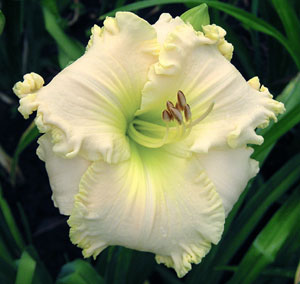
|
|
Check the germination rate.
Three weeks after planting, most of the seeds that will germinate have germinated. Germination rates usually vary between 85% - 90%. It looks like this year it will be about 87%, a little lower than last year. Germination is best when the soil is warm and that certainly is true here. Some years back, early September was one of the hottest on record including the hottest temperature ever recorded in Houston (109). I was concerned that the heat would adversely affect the newly planted seeds. The trays were in the sun in the driveway but they germinated and did just as well as any other year. My seed trays also survived hurricane Ike in 2008.
If for some reason germination rate is not acceptable, more seeds can be planted to make sure there will be enough seedlings for transplanting in the spring.
|
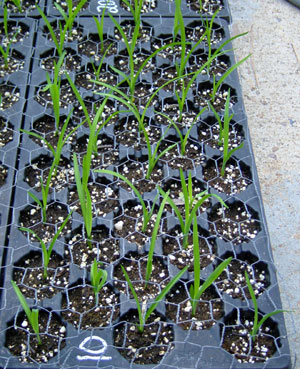 |
|
Albino seedlings
Sometimes a seed will germinate with white foliage. So what's up with that? (you might ask). These 'albino' seedings are reportedly the result of a mutated gene that controls the plant's ability to manufacture chlorophyll.
Chlorophyll (which gives the leaves their green color) is vital for photosynthesis, which allows plants to absorb energy from light. Without chlorophyll a daylily seedling cannot survive.
When a seed first germinates the sprout lives off the stored energy in the seed until it forms its own root and leaves and begins to manufacture chlorophyll. If it can't manufacture chlorophyll, when the energy stored in the seed is depleted the sprout will die. This usually happens within a few days up to a couple of weeks depending on the size of the seed.
|
|
| | | | | |
